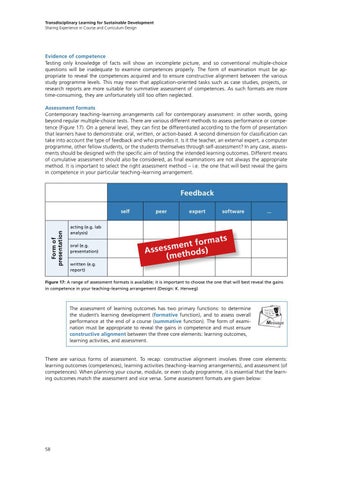Transdisciplinary Learning for Sustainable Development Sharing Experience in Course and Curriculum Design
Evidence of competence Testing only knowledge of facts will show an incomplete picture, and so conventional multiple-choice questions will be inadequate to examine competences properly. The form of examination must be appropriate to reveal the competences acquired and to ensure constructive alignment between the various study programme levels. This may mean that application-oriented tasks such as case studies, projects, or research reports are more suitable for summative assessment of competences. As such formats are more time-consuming, they are unfortunately still too often neglected. Assessment formats Contemporary teaching–learning arrangements call for contemporary assessment: in other words, going beyond regular multiple-choice tests. There are various different methods to assess performance or competence (Figure 17). On a general level, they can first be differentiated according to the form of presentation that learners have to demonstrate: oral, written, or action-based. A second dimension for classification can take into account the type of feedback and who provides it. Is it the teacher, an external expert, a computer programme, other fellow students, or the students themselves through self-assessment? In any case, assessments should be designed with the specific aim of testing the intended learning outcomes. Different means of cumulative assessment should also be considered, as final examinations are not always the appropriate method. It is important to select the right assessment method – i.e. the one that will best reveal the gains in competence in your particular teaching–learning arrangement.
Feedback
Form of presentation
self acting (e.g. lab analysis) oral (e.g. presentation)
peer
expert
software
...
ormats f t n e Assessmethods) (m
written (e.g. report)
Figure 17: A range of assessment formats is available; it is important to choose the one that will best reveal the gains in competence in your teaching–learning arrangement (Design: K. Herweg)
The assessment of learning outcomes has two primary functions: to determine the student’s learning development (formative function), and to assess overall performance at the end of a course (summative function). The form of examination must be appropriate to reveal the gains in competence and must ensure constructive alignment between the three core elements: learning outcomes, learning activities, and assessment. There are various forms of assessment. To recap: constructive alignment involves three core elements: learning outcomes (competences), learning activities (teaching–learning arrangements), and assessment (of competences). When planning your course, module, or even study programme, it is essential that the learning outcomes match the assessment and vice versa. Some assessment formats are given below:
58














